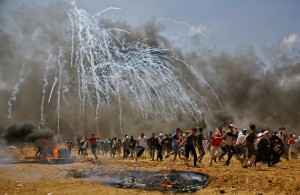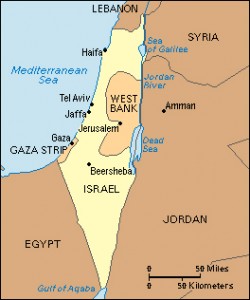Jerusalem Embassy Spurs Protests
Wednesday, May 16th, 2018May 16, 2018
On Monday, May 14, representatives from 32 nations attended the opening of the new United States Embassy in Jerusalem, the capital and largest city of Israel. The other 54 foreign delegations in Israel, however, avoided the ceremony, choosing to distance themselves from an event seen as controversial by much of the world. As Israeli Prime Minister Benjamin Netanyahu applauded with family members of U.S. President Donald Trump in Jerusalem, the embassy opening spurred a much different response in the nearby Gaza Strip, a small Palestinian-administered area between Israel and Egypt. There, Israeli security forces fired into massive crowds of protesting Palestinians, killing 60 people and injuring more than 2,700 others.

Palestinian protestors run from exploding tear gas canisters and gunfire by Israeli security forces near the Gaza Strip border with Israel on May 14, 2018. Credit: © Mohammed Abed, AFP/Getty Images
Jerusalem is a city bitterly divided by history, politics, and religion, and it lies at the center of a larger Arab-Israeli conflict. The conflict has included several wars between Israel and certain Arab countries that have opposed Israel’s existence since it was formed in 1948. The conflict has also involved a struggle by Palestinian Arabs to establish their own country in some or all of the land occupied by Israel.

Click to view larger image
Protests over the opening of the U.S. Embassy in Jerusalem took place about 50 miles (80 kilometers) away along the border between Israel and the Gaza Strip. Credit: WORLD BOOK map
In 1948, Jerusalem was declared an international city under the control of the United Nations. Fighting there soon divided the city between Israeli and Jordanian-Palestinian control. Israel claimed West Jerusalem as its capital, while Palestinians saw East Jerusalem as the capital of their future independent state. The city remained divided until 1967, when Israel captured the whole city in the Six-Day War. After another war in 1973, an awkward peace has held in an Israeli-controlled Jerusalem.
During all that time, foreign governments diplomatically kept away from Jerusalem and declined to officially recognize it as Israel’s capital. Foreign delegations were instead located in Tel Aviv, a city to the northwest. In December 2017, however, President Trump recognized Jerusalem as Israel’s capital. He also announced that the U.S. Embassy would move from Tel Aviv to Jerusalem. Trump’s decisions were widely condemned by the international community, and they were perceived by outraged Palestinians as mortal blows to their claims on East Jerusalem.
In late March 2018, Palestinian protestors in Gaza began gathering at the border fence, where they demanded entry to lands they once inhabited in Israel. (Hundreds of thousands of Palestinians have lived as refugees since Israel’s formation, and the “right of return” to their one-time homes is a dearly held principle.) The protests—sponsored by Hamas, a political group with hopes of restoring historic Palestine—were meant to draw attention to the Palestinian situation in the weeks leading up to the new U.S. Embassy’s opening. Israeli border troops reacted harshly to those earlier demonstrations, killing more than 40 Palestinians before Monday’s much larger protests and the coinciding spike in violence. Israel has been condemned for its seemingly excessive use of force against the largely unarmed protestors. Israel and the United States claim, however, that the bloody response is validated by the violent actions or intentions of some of the protestors.





